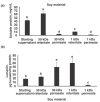Potential Health Benefits Associated with Lunasin Concentration in Dietary Supplements and Lunasin-Enriched Soy Extract
- PMID: 34065911
- PMCID: PMC8150303
- DOI: 10.3390/nu13051618
Potential Health Benefits Associated with Lunasin Concentration in Dietary Supplements and Lunasin-Enriched Soy Extract
Abstract
Lunasin has demonstrated antioxidative, anti-inflammatory, and chemopreventive properties. The objectives were to evaluate the concentration of lunasin in different lunasin-based commercial dietary supplements, to produce a lunasin-enriched soy extract (LESE) using a two-step pilot-plant-based ultrafiltration process, and to evaluate their biological potential in vitro. LESE was produced using 30 and 1 kDa membranes in a custom-made ultrafiltration skid. Lunasin was quantified in eight products and LESE. Lunasin concentrations of the lunasin-based products ranged from 9.2 ± 0.6 to 25.7 ± 1.1 mg lunasin/g protein. The LESE extract contained 58.2 mg lunasin/g protein, up to 6.3-fold higher lunasin enrichment than lunasin-based dietary supplements. Antioxidant capacity ranged from 121.5 mmol Trolox equivalents (TE)/g in Now® Kids to 354.4 mmol TE/g in LESE. Histone acetyltransferase (HAT) inhibition ranged from 5.3% on Soy Sentials® to 38.3% on synthetic lunasin. ORAC and lunasin concentrations were positively correlated, and HAT and lunasin concentrations were negatively correlated (p < 0.05). Melanoma B16-F10 and A375 cells treated with lunasin showed dose-dependent inhibitory potential (IC50 equivalent to 330 and 370 μM lunasin, respectively). Lunasin showed protein kinase B expression (57 ± 14%) compared to the control (100%) in B16-F10. Lunasin concentration found in commercial products and lunasin-enriched soy extract could exert benefits to consumers.
Keywords: anti-melanoma activity; antioxidant potential; lunasin-enriched soy extract; lunasin-rich supplements; ultrafiltration.
Conflict of interest statement
The authors declare no conflict of interest.
Figures






Similar articles
-
Analysis of lunasin in commercial and pilot plant produced soybean products and an improved method of lunasin purification.J Food Sci. 2012 May;77(5):C539-45. doi: 10.1111/j.1750-3841.2012.02676.x. Epub 2012 Apr 17. J Food Sci. 2012. PMID: 22510061
-
Lunasin concentration in different soybean genotypes, commercial soy protein, and isoflavone products.J Agric Food Chem. 2004 Sep 22;52(19):5882-7. doi: 10.1021/jf0496752. J Agric Food Chem. 2004. PMID: 15366837
-
Analysis of soybean protein-derived peptides and the effect of cultivar, environmental conditions, and processing on lunasin concentration in soybean and soy products.J AOAC Int. 2008 Jul-Aug;91(4):936-46. J AOAC Int. 2008. PMID: 18727556
-
"Potential health benefits of lunasin: a multifaceted soy-derived bioactive peptide".J Food Sci. 2015 Mar;80(3):R485-94. doi: 10.1111/1750-3841.12786. Epub 2015 Jan 27. J Food Sci. 2015. PMID: 25627564 Review.
-
Current state of art after twenty years of the discovery of bioactive peptide lunasin.Food Res Int. 2019 Feb;116:71-78. doi: 10.1016/j.foodres.2018.12.029. Epub 2018 Dec 22. Food Res Int. 2019. PMID: 30716999 Review.
Cited by
-
Contribution of Proteins and Peptides to the Impact of a Soy Protein Isolate on Oxidative Stress and Inflammation-Associated Biomarkers in an Innate Immune Cell Model.Plants (Basel). 2023 May 17;12(10):2011. doi: 10.3390/plants12102011. Plants (Basel). 2023. PMID: 37653928 Free PMC article.
-
Soybean (Glycine max) INFOGEST Colonic Digests Attenuated Inflammatory Responses Based on Protein Profiles of Different Varieties.Int J Mol Sci. 2023 Aug 3;24(15):12396. doi: 10.3390/ijms241512396. Int J Mol Sci. 2023. PMID: 37569771 Free PMC article.
-
Lunasin and Its Epigenetic Impact in Cancer Chemoprevention.Int J Mol Sci. 2023 May 24;24(11):9187. doi: 10.3390/ijms24119187. Int J Mol Sci. 2023. PMID: 37298139 Free PMC article. Review.
-
Evaluation of the Multifunctionality of Soybean Proteins and Peptides in Immune Cell Models.Nutrients. 2023 Feb 28;15(5):1220. doi: 10.3390/nu15051220. Nutrients. 2023. PMID: 36904220 Free PMC article.
-
Liposomes Loaded with Amaranth Unsaponifiable Matter and Soybean Lunasin Prevented Melanoma Tumor Development Overexpressing Caspase-3 in an In Vivo Model.Pharmaceutics. 2022 Oct 18;14(10):2214. doi: 10.3390/pharmaceutics14102214. Pharmaceutics. 2022. PMID: 36297649 Free PMC article.
References
-
- Dia V.P., Wang W., Oh V.L., de Lumen B.O., Gonzalez de Mejia E. Isolation, Purification and Characterisation of Lunasin from Defatted Soybean Flour and in Vitro Evaluation of Its Anti-Inflammatory Activity. Food Chem. 2009;114:108–115. doi: 10.1016/j.foodchem.2008.09.023. - DOI
-
- Pabona J.M.P., Dave B., Su Y., Montales M.T.E., de Lumen B.O., Gonzalez de Mejia E., Rahal O.M., Simmen R.C.M. The Soybean Peptide Lunasin Promotes Apoptosis of Mammary Epithelial Cells via Induction of Tumor Suppressor PTEN: Similarities and Distinct Actions from Soy Isoflavone Genistein. Genes Nutr. 2013;8:79–90. doi: 10.1007/s12263-012-0307-5. - DOI - PMC - PubMed
MeSH terms
Substances
LinkOut - more resources
Full Text Sources
Medical
Miscellaneous

